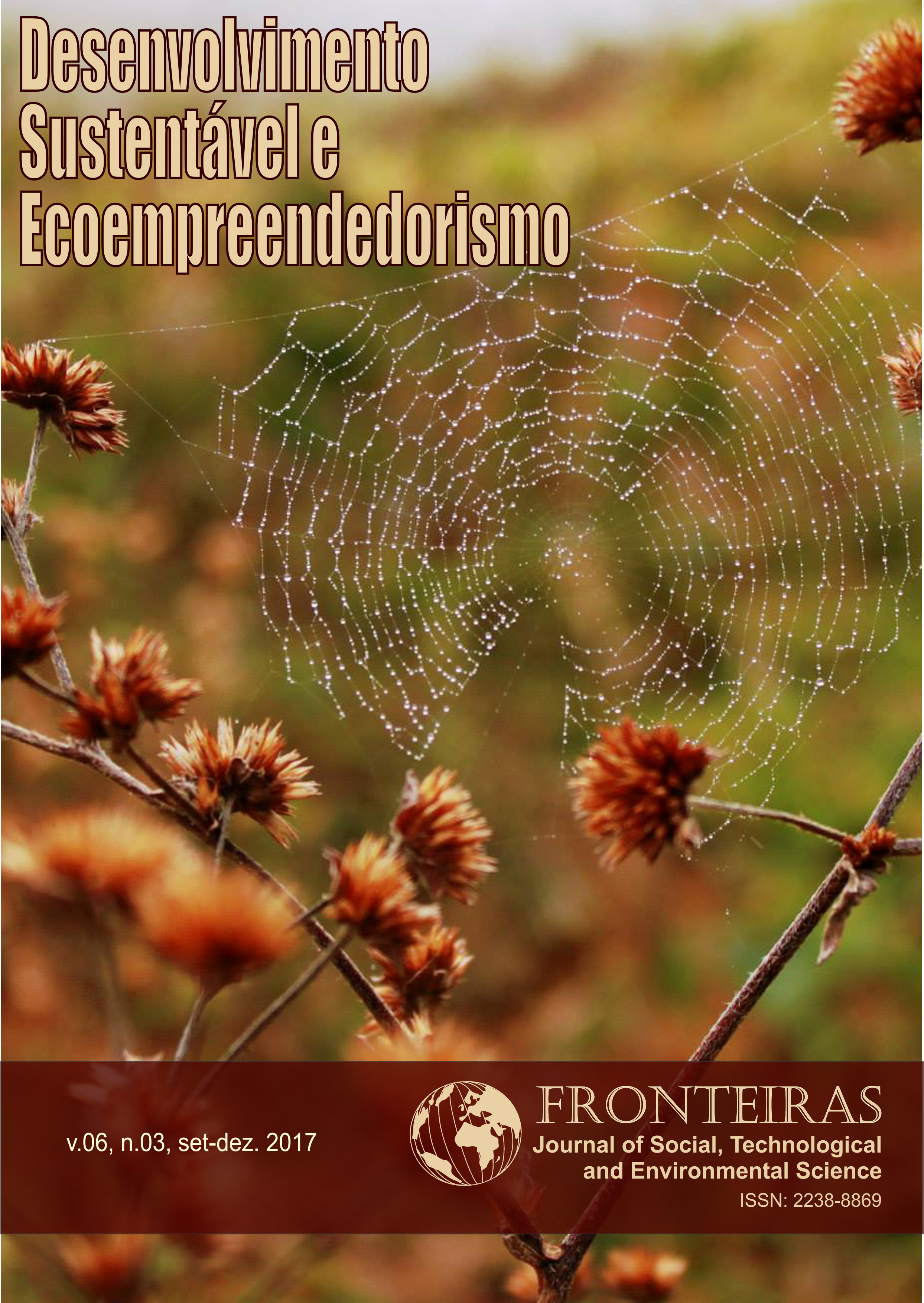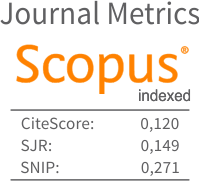Morfo-Anatomia de Folhas de Apeiba tibourbou Aubl. Malvaceae
DOI:
https://doi.org/10.21664/2238-8869.2017v6i3.p212-229Palavras-chave:
Escova de Macaco, Mucilagens, Tricomas, MalvaceaeResumo
Apeiba tibourbou Aubl. – Malvaceae é uma árvore, conhecida por escova de macaco, encontrada nos
trópicos (América Central e Sul), em florestas, preferencialmente matas e capoeiras. O objetivo deste trabalho foi realizar estudo morfo-anatômico de folhas desta espécie. Amostras de ramos férteis foram coletadas de indivíduos, nativos (Serra Dourada – Mossâmedes, Go.) e cultivados (Goiânia, GO.) no Instituto do Trópico Subúmido (ITS) – PUC Goiás. Realizaram-se cortes à mão livre e o destacamento da epiderme. Analisou o revestimento epidérmico, a organização do mesofilo e do sistema vascular. O pecíolo varia sua estrutura anatômica: região proximal contorno elíptico, mediana circular e distal plano convexo. A epiderme é unisseriada com células de formatos variados e contornos retilíneos. O sistema vascular é do tipo colateral e bicolateral. O mesofilo é dorsiventral com células coletoras, idioblastos com drusas, cavidades e canais mucilaginosos.
Referências
AKÇIN E O, OZBUCAK T B 2006. Morphological, anatomical and ecological studies on medicinal and edible plant Malva neglecta Wallr. (Malvaceae). Pakistan Journal of Biological Sciences, v. 9, n. 14, p. 2716-2719.
ANGIOSPERM PHYLOGENY GROUP 2003. An update of the Angiosperm Phylogeny Group classification for the orders and families of flowering plants: APG II. Botanical Journal of the Linnean Society. v. 141, p. 399-436.
APÓSTOLO, N M 2005. Caracteres anatómicos de la vegetación costera del Rio Salado (Noroeste de la provincia de Buenos Aires, Argentina). Bol. Soc. Argent. Bot. v. 40, n. 3 e 4, p. 215-227. APPEZZATO-DA-GLÓRIA B, CARMELLO-GUERREIRO, S M 2006. Anatomia Vegetal. (editoras) 2ª Ed. Atual. Viçosa: Ed. UFV. 438p.
BARBOSA M R V, LYRA-LEMOS R P, THOMAS W W, RODAL M J N, CARVALHO, A M 2005. Flora da estação ecológica de Murici, Alagoas. Atualizado em: <http://www.adaltech.com.br/ 20 dezembro de 2009, às 13h00min.
BAYER C, FAV M F, DE BRUIJN A Y, SAVOLAINE V, MORTON C M, KUBITZKI K, ALVERSON W S, CHASE M W 1999. Support for an explaned family concept of Malvaceae within a recircunscribed order Malvales: a combined analysis of plastid atpB and rbcL DNA sequences. Botanical Journal of the Linnaean Society. v.129, p. 267-303.
CARMELLO-GUERREIRO S M, PAOLI A A S 1999. Aspectos morfológicos e anatômicos da semente de aroeira (Myracrodruon urundeuva fr. allem. - Anacardiaceae), com notas sobre paquicalaza. Revista Brasileira de Sementes.v. 21, n. 1, p. 222-228.
DONATO A M, MORRETES B L 2009. Anatomia foliar de Eugenia florida DC. Myrtaceae). Revista Brasileira de Farmacognosia Brazilian Journal of Pharmacognosy 19(3): 759-770.
ESAU K 1974. Anatomia das plantas com sementes. Trad. Berta Lange de Morretes. São Paulo, Edgard Blucher, Ed. Universidade de São Paulo. 293 p.
FAHN A 1979. Secretory tissues in plants. London, Academic Press. 302 p.
FAHN A, CUTLER, D F 1992. Xerophytes. Encyclopedia of plant taxonomy. Gebrüder Borntraeger, Berlin.
GIRNOS E C 1993. Morfologia, anatomia e aspectos da germinação de Apeiba tibourbou Albl (Tiliaceae). Tese Doutorado. Rio Claro: Instituto de Biociência, Unesp, 161p.
GUIMARAES E F, MAUTONE L, RIZZINI C T, MATOS FILHO A 1993. Árvores do Jardim Botânico do Rio de Janeiro. Jardim Botânico, Rio de Janeiro, 198p.
HICKEY L J 1973. Classification of the architeture of dicotyledons leaves. American Journal of Botany. v. 60, n. 1, p. 17-33.
HICKEY L J 1979.A revised classification of the architeture of dicotyledons leaves. In: Metcalf C R, CHALK L (eds.). Anatomy of Dicotiledons. 2nd ed., Oxiford: Claredon Press, v. 1, p. 25-39.
JOHANSEN D A 2000. Plant Microtechnique. Mc Graw Hill Book, New York, 1940.
LARCHER W 2000. Ecofisiologia vegetal. ed. Rima. São Carlos. 531p.
LARROSA C R R, DUARTE M R Morfoanatomia de folhas de Himatanthus sucuuba (Spruce) Woodson, Apocynaceae Acta Farm. Bonaerense. v. 24, n. 2, p. 165-71, 2005.
LORENZI H 1998. Árvores brasileiras: Manual de identificação e cultivo de plantas arbóreas nativas do Brasil. 2.ed. Nova Odessa: Editora Plantarum, 352p.
LASURE A, VAN POEL B, PIETERS L, CLAYES M, GUPTA M, VANDEN BERGHE D, VLIENTINCK A 1994. Complemente inhibiting properties of Apeiba tibourbou Aubl. Planta medica, Stuttigart, v.60, p. 276-277.
MATOS, F. J. A 1994. Proposta de Validação Farmacognóstica de Drogas Vegetais, Plantas Medicinais e Fitoterápicos. Infarma, v. 3, p. 1-6.
METCALFE C R, CHALK L 1979. Anatomy of the Dicotyledons. 2ª Ed. vol. I. Clarendon Press. Oxford. 294 p.
METCALFE C R, CHALK L 1950. Anatomy of the Dicotyledons. Claredon Press, Oxford. METCALFE C R, CHALK L 1965. “Malvaceae” In: Anatomy of Dicotyledons. Clarendon Pres., v.I, Oxford, UK.
OUTER R W, SCHULTZ P R 1981. Wood anatomy of Apeiba (Tiliaceae). IAWA Bulletin, v. 2, n. 4.
ÖZKAN A M G, UZUNHISARCIKL M E 2009. Stem and leaf anatomy of Althaea L. (Malvaceae) species growing in Turkey. Hacettepe University Journal of the Faculty of Pharmacy, v. 28, n. 2, p. 133-148.
PAULA J E, IMAÑA-ENCINAS J, PEREIRA B A S 1996. Parâmetros volumétricos e da biomassa da mata ripária do Córrego dos Macacos. Cerne, v. 2, n. 2, p. 21-28.
ROCHA J F, NEVES L J, PACE L B 2002. Estruturas secretoras em folhas de Hibiscus tiliaceus L. e Hibiscus pernambucensis Arruda. Revista. Universidade Rural, Série. Ciências da Vida v. 22, n.1, p.43-55.
ROCHA J F, NEVES L 2000. Anatomia Foliar de Hibiscus tiliaceus L. e Hibiscus pernabuscensis Arruda (Malvaceae). Rodriguésia, v. 51, n. 78/79, p. 113-132.
ROTH I 1983. Estructura anatomica de la corteza d dos especies arboreas venezolanas de Tiliaceae. Acta Botánica Venezuelica, v. 14, n. 2.
SHAHEEN N, KHAN M A, YASMIN G, AHMAD M, MAHMOOD T, HAYAT M Q, ZAFAR M 2009. Foliar epidermal anatomy and its systematic implication within the genus Sida L. (malvaceae). African Journal of Biotechnology, v. 8 n. 20, p. 5328-5336.
SOLEREDER, H 1908. Systematic anatomy of the dicotyledons. A handbook for laboratories of pure and applied botany. v.I. Oxford. At the Clarendon Press.
TSCHÁ M. C, SALES M F, ESTEVES G L 2002. Tiliaceae Juss. no estado de Pernambuco, Brasil. Hoehnea, v. 29, n. 1, p. 1-18.
TAIZ L, E ZEIGER 2004. Fisiologia Vegetal. 3a ed. Artmed, Porto Alegre.
VALENTE M C, COSTA C G 2005 Estudo anatômico da flor demarsdenia loniceroides e. fournier (Asclepiadoideae– Apocynaceae). Rodriguésia. v. 56, n.87, p. 51-66.
VANNUCCI A L, REZENDE M H 2003. Anatomia Vegetal: noções básicas. Goiânia.
WALKER C I B, ZANETTI G D, CERON C S, MANFRON M P 2008. Morfoanatomia e Histoquímica das Folhas de Luehea divaricata Mart. Latin American Journal of Pharmacy, v. 27, n. 2, p. 203-10.
Downloads
Publicado
Como Citar
Edição
Seção
Licença
Esta revista oferece acesso livre imediato ao seu conteúdo, seguindo o princípio de que disponibilizar gratuitamente o conhecimento científico ao público proporciona maior democratização mundial do conhecimento.
A partir da publicação realizada na revista os autores possuem copyright e direitos de publicação de seus artigos sem restrições.
A Revista Fronteiras: Journal of Social, Technological and Environmental Science segue os preceitos legais da licença Creative Commons - Atribuição-NãoComercial 4.0 Internacional.


